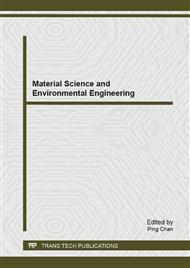[1]
W.H. Carothers, J.W. Hill, STUDIES OF POLYMERIZATION AND RING FORMATION. XV. ARTIFICIAL FIBERS FROM SYNTHETIC LINEAR CONDENSATION SUPERPOLYMERS, J. Am. Chem. Soc. 54 (1932) 1579-1587.
DOI: 10.1021/ja01343a051
Google Scholar
[2]
M.I. Kohan, Nylon Plastics Handbook. Vol. 378. 1995: Hanser Publishers Munich, Germany.
Google Scholar
[3]
P.W. Morgan, Condensation Polymers, Interscience Publishers New York, (1965).
Google Scholar
[4]
E.K. Bolton, Chemical Industry Medal. Development of Nylon, Ind. Eng. Chem. 34 (1942) 53-58.
DOI: 10.1021/ie50385a011
Google Scholar
[5]
V.G. Bankar, J.E. Spruiell, J.L. White, Melt spinning of nylon 6: Structure development and mechanical properties of as-spun filaments, J. Appl. Polym. Sci. 21 (1977) 2341-2358.
DOI: 10.1002/app.1977.070210905
Google Scholar
[6]
M.D. Danford, J.E. Spruiell, J.L. White, Structure development in the melt spinning of nylon 66 fibers and comparison to nylon 6, J. Appl. Polym. Sci. 22 (1978) 3351-3361.
DOI: 10.1002/app.1978.070221201
Google Scholar
[7]
T.F. Meyabadi, M.R.M. Mojtahedi, S.A.M. Shoushtari, Melt spinning of reused nylon 6: structure and physical properties of as-spun, drawn, and textured filaments, J. Tex. Inst. 101 (2010) 527-537.
DOI: 10.1080/00405000802561085
Google Scholar
[8]
R.S. Rahbar, M.R.M. Mojtahedi, Influence of Hot Multistage Drawing on Structure and Mechanical Properties of Nylon 6 Multifilament Yarn, J. Eng. Fibers Fabr. 6 (2011) 7-15.
DOI: 10.1177/155892501100600202
Google Scholar
[9]
N.S. Murthy, R.G. Bray, S.T. Correale, R.A.F. Moore, Drawing and annealing of nylon-6 fibres: studies of crystal growth, orientation of amorphous and crystalline domains and their influence on properties, Polymer. 36 (1995) 3863-3873.
DOI: 10.1016/0032-3861(95)99780-x
Google Scholar
[10]
J. Puiggalí, L. Franco, C. Alemán, J.A. Subirana, Crystal Structures of Nylon 5, 6. A Model with Two Hydrogen Bond Directions for Nylons Derived from Odd Diamines, Macromolecules. 31(1998) 8540-8548.
DOI: 10.1021/ma971895b
Google Scholar
[11]
L. Morales-Gámez, D. Soto, L. Franco, J. Puiggalí, Brill transition and melt crystallization of nylon 56: An odd–even polyamide with two hydrogen-bonding directions, Polymer. 51 (2010) 5788-5798.
DOI: 10.1016/j.polymer.2010.09.074
Google Scholar
[12]
R.S. Rahbar, A. Haji, Use of D-optimal design to model and the analysis of the effect of the draw ratio on some physical properties of hot multistage drawn nylon 6 fibers, J. Appl. Polym. Sci. 130 (2013) 1337-1344.
DOI: 10.1002/app.39254
Google Scholar
[13]
D.C. Prevorsek, G.A. Tirpak, P.J. Harget, A.C. Reimschuessel, Effects of thermal contraction on structure and properties of PET fibers, J. Macromol. Sci., Part B. 9 (1974) 733-759.
DOI: 10.1080/00222347408204559
Google Scholar
[14]
A. Suzuki, M. Ishihara, Application of CO2 laser heating zone drawing and zone annealing to nylon 6 fibers, J. Appl. Polym. Sci. 83 (2002) 1711-1716.
DOI: 10.1002/app.10094
Google Scholar


